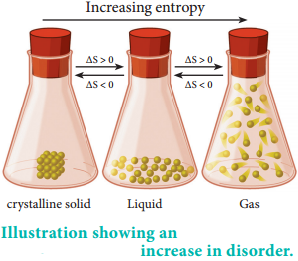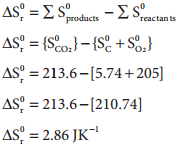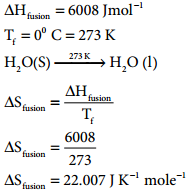Find free online Chemistry Topics covering a broad range of concepts from research institutes around the world.
Second Law of Thermodynamics
Need for the Second Law of Thermodynamics:
We know from the first law of thermodynamics, the energy of the universe is conserved. Let us consider the following processes:
1. A glass of hot water over time loses heat energy to the surrounding and becomes cold.
2. When you mix hydrochloric acid with sodium hydroxide, it forms sodium chloride and water with evolution of heat.
In both these processes, the total energy is conserved and are consistent with the first law of thermodynamics. However, the reverse process i.e. cold water becoming hot water by absorbing heat from surrounding on its own does not occur spontaneously even though the energy change involved in this process is also consistent with the first law.
However, if the heat energy is supplied to cold water, then it will become hot. i.e. the change that does not occur spontaneously and an be driven by supplying energy. Similarly, a solution of sodium chloride does not absorb heat energy on its own, to form hydrochloric acid and sodium hydroxide.
But, this process can not be driven even by supplying energy. From these kinds of our natural experiences, we have come to know that certain processes are spontaneous while the others are not, and some processes have a preferred direction. In order to explain the feasibility of a process, we need the second law of thermodynamics.
Various Statements of the Second Law of Thermodynamics
Entropy
The second law of thermodynamics introduces another state function called entropy. Entropy is a measure of the molecular disorder (randomness) of a system. But thermodynamic definition of entropy is concerned with the change in entropy that occurs as a result of a process.
It is defined as, dS = dqrev / T
Entropy Statement:
The second law of thermodynamics can be expressed in terms of entropy. i.e “the entropy of an isolated system increases during a spontaneous process”.
For an irreversible process such as spontaneous expansion of a gas,
∆Stotal > 0
∆Stotal > ∆Ssystem + ∆Ssurrounding
i.e; ∆Stotal > ∆Ssystem + ∆Ssurrounding
For a reversible process such as melting of ice,
ΔSsystem = – ∆Ssurrounding
∆Stotal = 0
Kelvin-Planck Statement:
It is impossible to construct a machine that absorbs heat from a hot source and converts it completely into work by a cyclic process without transferring a part of heat to a cold sink. The second law of thermodynamics explains why even an ideal, frictionless engine cannot convert 100% of its input heat into work.
Carnot on his analysis of heat engines, found that the maximum efficiency of a heat engine which operates reversibly, depends only on the two temperatures between which it is operated.
Efficiency = work performed / heat absorbed

qh – heat absorbed from the hot reservoir
qc – heat transferred to cold reservoir
 ………….. (7.27)
………….. (7.27)
For a reversible cyclic process

Th >> Tc
Hence, η < 1
Efficiency in percentage can be expressed as

Clausius Statement:
It is impossible to transfer heat from a cold reservoir to a hot reservoir without doing some work.
Problem: 7.10
If an automobile engine burns petrol at a temperature of 816° C and if the surrounding temperature is 21° C, calculate its maximum possible efficiency.
Solution:
% Efficiency = \(\left[\frac{\mathrm{T}_{\mathrm{h}}-\mathrm{T}_{\mathrm{c}}}{\mathrm{T}_{\mathrm{h}}}\right]\) × 100
Here
Th = 816 + 273 = 1089 K;
Tc = 21 + 273 = 294 K
% Efficiency = (\(\frac{1089-294}{1089}\)) × 100
% Efficiency = 73%
Unit of Entropy:
The entropy (S) is equal to heat energy exchanged (q) divided by the temperature (T) at which the exchange takes place. Therefore, The SI unit of entropy is JK-1.
Spontaneity and Randomness
Careful examination shows that in each of the processes viz., melting of ice and evaporation of water, there is an increase in randomness or disorder of the system. The water molecules in ice are arranged in a highly organised crystal pattern which permits little movement. As the ice melts, the water molecules become disorganised and can move more freely.
The movement of molecules becomes freer in the liquid phase and even more free in the vapour phase. In other words, we can say that the randomness of the water molecules increases, as ice melts into water or water evaporates. Both are spontaneous processes which result in a increase in randomness (entropy).

Standard Entropy Change(ΔS°):
It is possible to calculate the actual entropy of a substance at any temperature above 0 K. The absolute entropy of a substance at 298 K and one bar pressure is called the standard entropy So. The third law of thermodynamics states, according to Nernst, that the absolute entropy of elements is zero only at 0 K in a perfect crystal, and standard entropies of all substances at any temperature above 0 K always have positive values. Once we know the entropies of different substances, we can calculate the standard entropy change (∆S°r) for chemical reactions.
∆S°r = ΣS°products – ΣS°reactants …………… (7.30)
Standard Entropy of Formation:
Standard entropy of formation is defined as “the entropy of formation of 1 mole of a compound from the elements under standard conditions”. It is denoted as ∆S°f. We can calculate the value of entropy of a given compound from the values of S° of elements.
Problem: 7.6
Calculate the standard entropy change for the following reaction (∆S°f), given the standard entropies of CO2(g), C(s), O2(g) as 213.6 , 5.740 and 205 JK-1 respectively.
C(g) + O2(g) → CO2(g)

Entropy Change Accompanying Change of Phase
When there is a change of state from solid to liquid (melting), liquid to vapour (evaporation) or solid to vapour (sublimation) there is a change in entropy. This change may be carried out at constant temperature reversibly as two phases are in equilibrium during the change.
![]() …………… (7.31)
…………… (7.31)
Entropy of Fusion:
The heat absorbed, when one mole of a solid melts at its melting point reversibly, is called molar heat of fusion. The entropy change for this process is given by
 …………. (7.32)
…………. (7.32)
where ∆Hfusion is Molar heat of fusion. Tf is the melting point.
Entropy of Vapourisation:
The heat absorbed, when one mole of liquid is boiled at its boiling point reversibly, is called molar heat of vapourisation. The entropy change is given by
![]() …………… (7.33)
…………… (7.33)
where ΔHv is Molar heat of vaporisation. Tb is the boiling point.
Entropy of Transition:
The heat change, when one mole of a solid changes reversibly from one allotropic form to another at its transition temperature is called enthalpy of transition. The entropy change is given
![]() …………….. (7.34)
…………….. (7.34)
where ΔHt is the molar heat of transition, Tt is the transition temperature.
Problem: 7.7
Calculate the entropy change during the melting of one mole of ice into water at 0° C and 1 atm pressure. Enthalpy of fusion of
ice is 6008 J mol-1.
Given:
